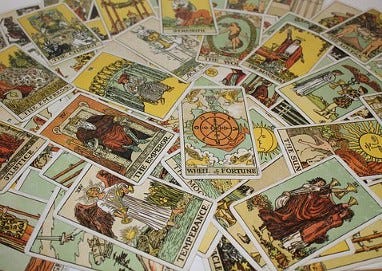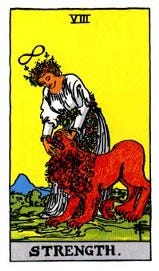
I imagine that many readers’ first response to that question might be ‘What does it matter?’, or even ‘who cares?’. It depends, I suppose, on how much value one assigns to this mysterious deck of cards. Along with many others, I believe that it contains great depths of wisdom. (In a recent article, I described the journey through the major arcana, click here if interested.) If the Tarot is much older than is usually believed, that would mean this wisdom has survived for perhaps thousands of years rather than hundreds. This would give it even greater weight, if it has impressed people for so long.
The conventional viewpoint has been expressed clearly on Medium.com by Joshua Hehe¹: “The speculations about the creators of Tarot cards include the Sufis, the Cathars, the Egyptians, Kabbalists, Gypsies, and more. However, all of the actual historical evidence points to northern Italy sometime in the early part of the 1400s. Contrary to what many have claimed, there is absolutely no proof of the Tarot having originated in any other time or place”.
Of course, this leaves open the question of who originated the Tarot in Italy, and what their sources, background and inspiration were.
So, I’m going to do a brief series of articles on the age of the Tarot. This is intended neither as a criticism, a response, nor a refutation of what Joshua Hehe says. I am happy to agree that there is “absolutely no proof” that the Tarot cards originated earlier. My intention is merely to explore some of these “speculations”, to see whether they might have any validity and, if so, how much. The main question will be, even if the Tarot cards did not exist, were their images and the underlying philosophy established in earlier times? The later cards may merely be one manifestation of this philosophy.
In criminal trials different types of evidence are allowed; the best is direct, that which constitutes conclusive proof, but circumstantial evidence is also allowed. If enough convincing circumstantial evidence is brought forward, then this can be considered important enough to be included when arriving at a verdict. So, is there any circumstantial evidence that the Tarot goes back earlier?

My first observation relates to card 8 from the major arcana, Strength, which depicts a spiritual female figure apparently trying to close a lion’s mouth. This is about developing a right relationship with, learning to control, one’s passions, desires, biological drives (what Sigmund Freud called the id), symbolised by a lion. It is important that we all tame our wild side, and not allow the lion within us to take us over.
Compare this to logia 7 of the gnostic Gospel According to Thomas: “Jesus said, ‘Blessed is the lion that the human being will devour so that the lion becomes human. And cursed is the human being that the lion devours; and the lion will become human’ ”².
I hope I’m not reading too much into this, but ‘Jesus’ here seems to be referring to the theme of this Tarot card, saying that humans must not allow themselves to be taken over by their leonine wild nature. It is irrelevant whether or not any historical Jesus ever said these words; what is clear is that the lion as a symbol of our biological drives was current whenever this gospel was written, let’s say no later than the 2nd century. This obviously does not mean that the Tarot card existed at that time, only that its theme, and the same imagery were current.
I’ll make further observations in later articles.
======================================================================================================
Footnotes:
1.‘The Real History of Tarot Cards’, click here. 2. The Gnostic Scriptures, translated by Bentley Layton, Doubleday, 1987, p381